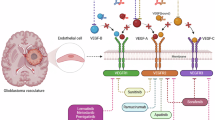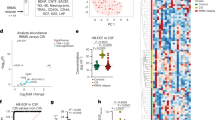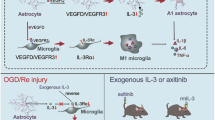Abstract
The impairment of blood-brain barrier (BBB) integrity is the pathological basis of hemorrhage transformation and vasogenic edema following thrombolysis and endovascular therapy. There is no approved drug in the clinic to reduce BBB damage after acute ischemic stroke (AIS). Glial growth factor 2 (GGF2), a recombinant version of neuregulin-1β that can stimulates glial cell proliferation and differentiation, has been shown to alleviate free radical release from activated microglial cells. We previously found that activated microglia and proinflammatory factors could disrupt BBB after AIS. In this study we investigated the effects of GGF2 on AIS-induced BBB damage as well as the underlying mechanisms. Mouse middle cerebral artery occlusion model was established: mice received a 90-min ischemia and 22.5 h reperfusion (I/R), and were treated with GGF2 (2.5, 12.5, 50 ng/kg, i.v.) before the reperfusion. We showed that GGF2 treatment dose-dependently decreased I/R-induced BBB damage detected by Evans blue (EB) and immunoglobulin G (IgG) leakage, and tight junction protein occludin degradation. In addition, we found that GGF2 dose-dependently reversed AIS-induced upregulation of vesicular transcytosis increase, caveolin-1 (Cav-1) as well as downregulation of major facilitator superfamily ___domain containing 2a (Mfsd2a). Moreover, GGF2 decreased I/R-induced upregulation of PDZ and LIM ___domain protein 5 (Pdlim5), an adaptor protein that played an important role in BBB damage after AIS. In addition, GGF2 significantly alleviated I/R-induced reduction of YAP and TAZ, microglial cell activation and upregulation of inflammatory factors. Together, these results demonstrate that GGF2 treatment alleviates the I/R-compromised integrity of BBB by inhibiting Mfsd2a/Cav-1-mediated transcellular permeability and Pdlim5/YAP/TAZ-mediated paracellular permeability.
This is a preview of subscription content, access via your institution
Access options
Subscribe to this journal
Receive 12 print issues and online access
269,00 € per year
only 22,42 € per issue
Buy this article
- Purchase on SpringerLink
- Instant access to full article PDF
Prices may be subject to local taxes which are calculated during checkout








Similar content being viewed by others
References
Desilles JP, Rouchaud A, Labreuche J, Meseguer E, Laissy JP, Serfaty JM, et al. Blood-brain barrier disruption is associated with increased mortality after endovascular therapy. Neurology. 2013;80:844–51.
Ridder DA, Wenzel J, Müller K, Töllner K, Tong XK, Assmann JC, et al. Brain endothelial TAK1 and NEMO safeguard the neurovascular unit. J Exp Med. 2015;212:1529–49.
Won S, Sayeed I, Peterson BL, Wali B, Kahn JS, Stein DG. Vitamin D prevents hypoxia/reoxygenation-induced blood-brain barrier disruption via vitamin D receptor-mediated NF-kappaB signaling pathways. PLoS One. 2015;10:e0122821.
Chen B, Friedman B, Cheng Q, Tsai P, Schim E, Kleinfeld D, et al. Severe blood-brain barrier disruption and surrounding tissue injury. Stroke. 2009;40:e666–74.
Wang YP, Du WH, Hu XY, Yu X, Guo C, Jin XC, et al. Targeting the blood-brain barrier to delay aging-accompanied neurological diseases by modulating gut microbiota, circadian rhythms, and their interplays. Acta Pharmaceutica Sin B. 2023;13:4667–87.
Ben-Zvi A, Lacoste B, Kur E, Andreone BJ, Mayshar Y, Yan H, et al. Mfsd2a is critical for the formation and function of the blood-brain barrier. Nature. 2014;509:507–11.
Andreone BJ, Chow BW, Tata A, Lacoste B, Ben-Zvi A, Bullock K, et al. Blood-brain barrier permeability is regulated by lipid transport-dependent suppression of caveolae-mediated transcytosis. Neuron. 2017;94:581–94. e5
Zhao C, Ma J, Wang Z, Li H, Shen H, Li X, et al. Mfsd2a attenuates blood-brain barrier disruption after sub-arachnoid hemorrhage by inhibiting caveolae-mediated transcellular transport in rats. Transl Stroke Res. 2020;11:1012–27.
Yang YR, Xiong XY, Liu J, Wu LR, Zhong Q, Zhou K, et al. Mfsd2a (Major facilitator superfamily ___domain containing 2a) attenuates intracerebral hemorrhage-induced blood-brain barrier disruption by inhibiting vesicular transcytosis. J Am Heart Assoc. 2017;6:e005811.
Eser Ocak P, Ocak U, Sherchan P, Gamdzyk M, Tang J, Zhang JH. Overexpression of Mfsd2a attenuates blood brain barrier dysfunction via Cav-1/Keap-1/Nrf-2/HO-1 pathway in a rat model of surgical brain injury. Exp Neurol. 2020;326:113203.
Hussain B, Fang C, Huang X, Feng Z, Yao Y, Wang Y, et al. Endothelial beta-catenin deficiency causes blood-brain barrier breakdown via enhancing the paracellular and transcellular permeability. Front Mol Neurosci. 2022;15:895429.
Gong P, Zhang Z, Zou C, Tian Q, Chen X, Hong M, et al. Hippo/YAP signaling pathway mitigates blood-brain barrier disruption after cerebral ischemia/reperfusion injury. Behav Brain Res. 2019;356:8–17.
Hu X, Dong J, Geng P, Sun Y, Du W, Zhao X, et al. Nicotine treatment ameliorates blood-brain barrier damage after acute ischemic stroke by regulating endothelial scaffolding protein Pdlim5. Transl Stroke Res. 2024;15:672–87.
Elbediwy A, Vanyai H, Diaz-de-la-Loza MD, Frith D, Snijders AP, Thompson BJ. Enigma proteins regulate YAP mechanotransduction. J Cell Sci. 2018;131:jcs221788.
Carraway KL, Burden SJ. Neuregulins and their receptors. Curr Opin Neurobiol. 1995;5:606–12.
Lok J, Sardi SP, Guo S, Besancon E, Ha DM, Rosell A, et al. Neuregulin-1 signaling in brain endothelial cells. J Cereb Blood Flow Metab. 2009;29:39–43.
Lok J, Zhao S, Leung W, Seo JH, Navaratna D, Wang X, et al. Neuregulin-1 effects on endothelial and blood-brain-barrier permeability after experimental injury. Transl Stroke Res. 2012;3:S119–24.
Ji Y, Teng L, Zhang R, Sun J, Guo Y. NRG-1beta exerts neuroprotective effects against ischemia reperfusion-induced injury in rats through the JNK signaling pathway. Neuroscience. 2017;362:13–24.
Xu Z, Ford BD. Upregulation of erbB receptors in rat brain after middle cerebral arterial occlusion. Neurosci Lett. 2005;375:181–6.
Qian H, Dou Z, Ruan W, He P, Zhang JH, Yan F. ErbB4 preserves blood-brain barrier integrity via the YAP/PIK3CB pathway after subarachnoid hemorrhage in rats. Front Neurosci. 2018;12:492.
Li F, Liu WC, Wang Q, Sun Y, Wang H, Jin X. NG2-glia cell proliferation and differentiation by glial growth factor 2 (GGF2), a strategy to promote functional recovery after ischemic stroke. Biochem Pharmacol. 2020;171:113720.
Wu L, Ramirez SH, Andrews AM, Leung W, Itoh K, Wu J, et al. Neuregulin1-beta decreases interleukin-1beta-induced RhoA activation, myosin light chain phosphorylation, and endothelial hyperpermeability. J Neurochem. 2016;136:250–7.
Wu L, Walas S, Leung W, Sykes DB, Wu J, Lo EH, et al. Neuregulin1-beta decreases IL-1beta-induced neutrophil adhesion to human brain microvascular endothelial cells. Transl Stroke Res. 2014;6:116–24.
Ryzhov S, Matafonov A, Galindo CL, Zhang Q, Tran TL, Lenihan DJ, et al. ERBB signaling attenuates proinflammatory activation of nonclassical monocytes. Am J Physiol Heart Circ Physiol. 2017;312:H907–H18.
Dimayuga FO, Ding Q, Keller JN, Marchionni MA, Seroogy KB, Bruce-Keller AJ. The neuregulin GGF2 attenuates free radical release from activated microglial cells. J Neuroimmunol. 2003;136:67–74.
Chen S, Sun Y, Li F, Zhang X, Hu X, Zhao X, et al. Modulation of alpha7nAchR by melatonin alleviates ischemia and reperfusion-compromised integrity of blood-brain barrier through inhibiting hmgb1-mediated microglia activation and crtc1-mediated neuronal loss. Cell Mol Neurobiol. 2022;42:2407–22.
Liu Y, Liu WC, Sun Y, Shen X, Wang X, Shu H, et al. Normobaric hyperoxia extends neuro- and vaso-protection of N-acetylcysteine in transient focal ischemia. Mol Neurobiol. 2017;54:3418–27.
Wang X, Liu Y, Sun Y, Liu W, Jin X. Blood brain barrier breakdown was found in non-infarcted area after 2-h MCAO. J Neurol Sci. 2016;363:63–8.
Shu H, Wang M, Song M, Sun Y, Shen X, Zhang J, et al. Acute nicotine treatment alleviates LPS-induced impairment of fear memory reconsolidation through AMPK activation and CRTC1 upregulation in hippocampus. Int J Neuropsychopharmacol. 2020;23:687–99.
Wang Y, Wang X, Zhang X, Chen S, Sun Y, Liu W, et al. D1 receptor-mediated endogenous tPA upregulation contributes to blood-brain barrier injury after acute ischaemic stroke. J Cell Mol Med. 2020;24:9255–66.
Warach S, Latour LL. Evidence of reperfusion injury, exacerbated by thrombolytic therapy, in human focal brain ischemia using a novel imaging marker of early blood-brain barrier disruption. Stroke. 2004;35:2659–61.
Hawkins BT, Davis TP. The blood-brain barrier/neurovascular unit in health and disease. Pharmacol Rev. 2005;57:173–85.
Gong S, Ma H, Zheng F, Huang J, Zhang Y, Yu B, et al. Inhibiting YAP in endothelial cells from entering the nucleus attenuates blood-brain barrier damage during ischemia-reperfusion injury. Front Pharmacol. 2021;12:777680.
Ma Y, Wang J, Wang Y, Yang GY. The biphasic function of microglia in ischemic stroke. Prog Neurobiol. 2017;157:247–72.
Versele R, Sevin E, Gosselet F, Fenart L, Candela P. TNF-alpha and IL-1beta modulate blood-brain barrier permeability and decrease amyloid-beta peptide efflux in a human blood-brain barrier model. Int J Mol Sci. 2022;23:10235.
Jin X, Liu J, Liu W. Early Ischemic blood brain barrier damage: A potential indicator for hemorrhagic transformation following tissue plasminogen activator (tPA) thrombolysis? Curr Neurovasc Res. 2014;11:254–62.
Jin X, Liu J, Yang Y, Liu KJ, Liu W. Spatiotemporal evolution of blood brain barrier damage and tissue infarction within the first 3h after ischemia onset. Neurobiol Dis. 2012;48:309–16.
Shen Y, Gu J, Liu Z, Xu C, Qian S, Zhang X, et al. Inhibition of HIF-1alpha reduced blood brain barrier damage by regulating MMP-2 and vegf during acute cerebral ischemia. Front Cell Neurosci. 2018;12:288.
Sun Y, Chen X, Zhang X, Shen X, Wang M, Wang X, et al. β2-Adrenergic receptor-mediated HIF-1alpha upregulation mediates blood brain barrier damage in acute cerebral ischemia. Front Mol Neurosci. 2017;10:257.
Jin X, Liu J, Liu KJ, Rosenberg GA, Yang Y, Liu W. Normobaric hyperoxia combined with minocycline provides greater neuroprotection than either alone in transient focal cerebral ischemia. Exp Neurol. 2013;240:9–16.
Khatri R, McKinney AM, Swenson B, Janardhan V. Blood-brain barrier, reperfusion injury, and hemorrhagic transformation in acute ischemic stroke. Neurology. 2012;79:S52–7.
Moskowitz MA, Lo EH, Iadecola C. The science of stroke: mechanisms in search of treatments. Neuron. 2010;67:181–98.
Xu Z, Jiang J, Ford G, Ford BD. Neuregulin-1 is neuroprotective and attenuates inflammatory responses induced by ischemic stroke. Biochem Biophys Res Commun. 2004;322:440–6.
Ayloo S, Gu C. Transcytosis at the blood-brain barrier. Curr Opin Neurobiol. 2019;57:32–8.
Nag S, Venugopalan R, Stewart DJ. Increased caveolin-1 expression precedes decreased expression of occludin and claudin-5 during blood-brain barrier breakdown. Acta Neuropathol. 2007;114:459–69.
Song L, Ge S, Pachter JS. Caveolin-1 regulates expression of junction-associated proteins in brain microvascular endothelial cells. Blood. 2007;109:1515–23.
Zhang CL, Wang HL, Li PC, Hong CD, Chen AQ, Qiu YM, et al. Mfsd2a overexpression alleviates vascular dysfunction in diabetic retinopathy. Pharmacol Res. 2021;171:105755.
Cui Y, Wang Y, Song X, Ning H, Zhang Y, Teng Y, et al. Brain endothelial PTEN/AKT/NEDD4-2/MFSD2A axis regulates blood-brain barrier permeability. Cell Rep. 2021;36:109327.
Gu Y, Zheng G, Xu M, Li Y, Chen X, Zhu W, et al. Caveolin-1 regulates nitric oxide-mediated matrix metalloproteinases activity and blood-brain barrier permeability in focal cerebral ischemia and reperfusion injury. J Neurochem. 2012;120:147–56.
de Wit NM, Vanmol J, Kamermans A, Hendriks JJA, de Vries HE. Inflammation at the blood-brain barrier: the role of liver X receptors. Neurobiol Dis. 2017;107:57–65.
Dohgu S, Banks WA. Lipopolysaccharide-enhanced transcellular transport of HIV-1 across the blood-brain barrier is mediated by the p38 mitogen-activated protein kinase pathway. Exp Neurol. 2008;210:740–9.
Erickson MA, Shulyatnikova T, Banks WA, Hayden MR. Ultrastructural remodeling of the blood-brain barrier and neurovascular unit by lipopolysaccharide-induced neuroinflammation. Int J Mol Sci. 2023;24:1640.
da Fonseca AC, Matias D, Garcia C, Amaral R, Geraldo LH, Freitas C, et al. The impact of microglial activation on blood-brain barrier in brain diseases. Front Cell Neurosci. 2014;8:362.
Xu Z, Ford GD, Croslan DR, Jiang J, Gates A, Allen R, et al. Neuroprotection by neuregulin-1 following focal stroke is associated with the attenuation of ischemia-induced pro-inflammatory and stress gene expression. Neurobiol Dis. 2005;19:461–70.
Acknowledgements
This work was supported by Zhejiang Provincial Natural Science Foundation of China (LTGY24H090002), the Medical and Health Science and Technology Plan Project of Zhejiang Province (2024KY1685), and Jiaxing Plan of Science and Technology (2022AY30028). This work was also supported by by National Natural Science Foundation of China (81870973, 81671145).
Author information
Authors and Affiliations
Contributions
WHD, performed the majority experiments. JLD, MS, YYS participated in some experiments. WHD made the figures. XLZ, SXQ, XDL interpreted the data and drafted the manuscript. XLZ, XY, HLF, XQW, YFS, YNH, MHS, and BQZ participated in the study design and provided some suggestions. XLZ, CYX, YPW, and XCJ supervised the study, reviewed the original data, and finalized the manuscript. All authors have read and approved the final manuscript.
Corresponding authors
Ethics declarations
Competing interests
The authors declare no competing interests.
Rights and permissions
Springer Nature or its licensor (e.g. a society or other partner) holds exclusive rights to this article under a publishing agreement with the author(s) or other rightsholder(s); author self-archiving of the accepted manuscript version of this article is solely governed by the terms of such publishing agreement and applicable law.
About this article
Cite this article
Zhang, Xl., Du, Wh., Qian, Sx. et al. Glial growth factor 2 treatment alleviates ischemia and reperfusion-damaged integrity of the blood-brain barrier through decreasing Mfsd2a/caveolin-1-mediated transcellular and Pdlim5/YAP/TAZ-mediated paracellular permeability. Acta Pharmacol Sin 45, 2241–2252 (2024). https://doi.org/10.1038/s41401-024-01323-7
Received:
Accepted:
Published:
Issue Date:
DOI: https://doi.org/10.1038/s41401-024-01323-7



